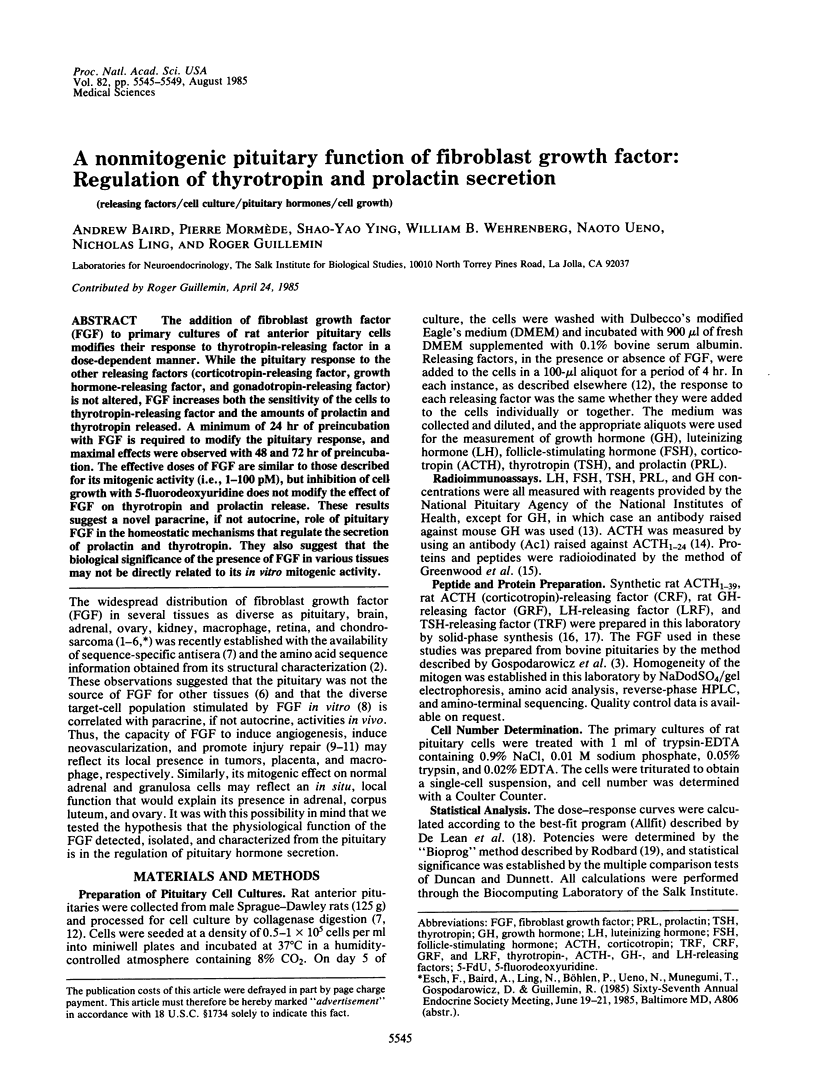Abstract
The addition of fibroblast growth factor (FGF) to primary cultures of rat anterior pituitary cells modifies their response to thyrotropin-releasing factor in a dose-dependent manner. While the pituitary response to the other releasing factors (corticotropin-releasing factor, growth hormone-releasing factor, and gonadotropin-releasing factor) is not altered, FGF increases both the sensitivity of the cells to thyrotropin-releasing factor and the amounts of prolactin and thyrotropin released. A minimum of 24 hr of preincubation with FGF is required to modify the pituitary response, and maximal effects were observed with 48 and 72 hr of preincubation. The effective doses of FGF are similar to those described for its mitogenic activity (i.e., 1-100 pM), but inhibition of cell growth with 5-fluorodeoxyuridine does not modify the effect of FGF on thyrotropin and prolactin release. These results suggest a novel paracrine, if not autocrine, role of pituitary FGF in the homeostatic mechanisms that regulate the secretion of prolactin and thyrotropin. They also suggest that the biological significance of the presence of FGF in various tissues may not be directly related to its in vitro mitogenic activity.
Full text
PDF




Selected References
These references are in PubMed. This may not be the complete list of references from this article.
- Baird A., Mormède P., Böhlen P. Immunoreactive fibroblast growth factor in cells of peritoneal exudate suggests its identity with macrophage-derived growth factor. Biochem Biophys Res Commun. 1985 Jan 16;126(1):358–364. doi: 10.1016/0006-291x(85)90614-x. [DOI] [PubMed] [Google Scholar]
- Böhlen P., Baird A., Esch F., Ling N., Gospodarowicz D. Isolation and partial molecular characterization of pituitary fibroblast growth factor. Proc Natl Acad Sci U S A. 1984 Sep;81(17):5364–5368. doi: 10.1073/pnas.81.17.5364. [DOI] [PMC free article] [PubMed] [Google Scholar]
- Clayton R. N., Solano A. R., Garcia-Vela A., Dufau M. L., Catt K. J. Regulation of pituitary receptors for gonadotropin-releasing hormone during the rat estrous cycle. Endocrinology. 1980 Sep;107(3):699–706. doi: 10.1210/endo-107-3-699. [DOI] [PubMed] [Google Scholar]
- DeLean A., Munson P. J., Rodbard D. Simultaneous analysis of families of sigmoidal curves: application to bioassay, radioligand assay, and physiological dose-response curves. Am J Physiol. 1978 Aug;235(2):E97–102. doi: 10.1152/ajpendo.1978.235.2.E97. [DOI] [PubMed] [Google Scholar]
- Fink G. Feedback actions of target hormones on hypothalamus and pituitary with special reference to gonadal steroids. Annu Rev Physiol. 1979;41:571–585. doi: 10.1146/annurev.ph.41.030179.003035. [DOI] [PubMed] [Google Scholar]
- GREENWOOD F. C., HUNTER W. M., GLOVER J. S. THE PREPARATION OF I-131-LABELLED HUMAN GROWTH HORMONE OF HIGH SPECIFIC RADIOACTIVITY. Biochem J. 1963 Oct;89:114–123. doi: 10.1042/bj0890114. [DOI] [PMC free article] [PubMed] [Google Scholar]
- Gospodarowicz D., Cheng J., Lui G. M., Baird A., Böhlent P. Isolation of brain fibroblast growth factor by heparin-Sepharose affinity chromatography: identity with pituitary fibroblast growth factor. Proc Natl Acad Sci U S A. 1984 Nov;81(22):6963–6967. doi: 10.1073/pnas.81.22.6963. [DOI] [PMC free article] [PubMed] [Google Scholar]
- Gospodarowicz D. Localisation of a fibroblast growth factor and its effect alone and with hydrocortisone on 3T3 cell growth. Nature. 1974 May 10;249(453):123–127. doi: 10.1038/249123a0. [DOI] [PubMed] [Google Scholar]
- Gospodarowicz D., Mescher A. L. Fibroblast growth factor and the control of vertebrate regeneration and repair. Ann N Y Acad Sci. 1980;339:151–174. doi: 10.1111/j.1749-6632.1980.tb15976.x. [DOI] [PubMed] [Google Scholar]
- Ling N., Esch F., Davis D., Mercado M., Regno M., Bohlen P., Brazeau P., Guillemin R. Solid phase synthesis of somatostatin-28. Biochem Biophys Res Commun. 1980 Aug 14;95(3):945–951. doi: 10.1016/0006-291x(80)91564-8. [DOI] [PubMed] [Google Scholar]
- Mormède P., Baird A., Pigeon P. Immunoreactive fibroblast growth factor (FGF) in rat tissues: molecular weight forms and the effects of hypophysectomy. Biochem Biophys Res Commun. 1985 May 16;128(3):1108–1113. doi: 10.1016/0006-291x(85)91054-x. [DOI] [PubMed] [Google Scholar]
- Neill J. D., Frawley L. S. Detection of hormone release from individual cells in mixed populations using a reverse hemolytic plaque assay. Endocrinology. 1983 Mar;112(3):1135–1137. doi: 10.1210/endo-112-3-1135. [DOI] [PubMed] [Google Scholar]
- PASTEELS J. L. RECHERCHES MORPHOLOGIQUES ET EXP'ERIMENTALES SUR LA S'ECR'ETION DE PROLACTINE. Arch Biol (Liege) 1963;74:439–553. [PubMed] [Google Scholar]
- Rodbard D. Statistical quality control and routine data processing for radioimmunoassays and immunoradiometric assays. Clin Chem. 1974 Oct;20(10):1255–1270. [PubMed] [Google Scholar]
- Schonbrunn A., Krasnoff M., Westendorf J. M., Tashjian A. H., Jr Epidermal growth factor and thyrotropin-releasing hormone act similarly on a clonal pituitary cell strain. Modulation of hormone production and inhbition of cell proliferation. J Cell Biol. 1980 Jun;85(3):786–797. doi: 10.1083/jcb.85.3.786. [DOI] [PMC free article] [PubMed] [Google Scholar]
- Sinha Y. N., Selby F. W., Lewis U. J., VanderLaan W. P. Studies of GH secretion in mice by a homologous radioimmunoassay for mouse GH. Endocrinology. 1972 Sep;91(3):784–792. doi: 10.1210/endo-91-3-784. [DOI] [PubMed] [Google Scholar]
- Walker A. M., Farquhar M. G. Preferential release of newly synthesized prolactin granules is the result of functional heterogeneity among mammotrophs. Endocrinology. 1980 Oct;107(4):1095–1104. doi: 10.1210/endo-107-4-1095. [DOI] [PubMed] [Google Scholar]
- Wehrenberg W. B., Baird A., Ying S. Y., Rivier C., Ling N., Guillemin R. Multiple stimulation of the adenohypophysis by combinations of hypothalamic releasing factors. Endocrinology. 1984 Jun;114(6):1995–2001. doi: 10.1210/endo-114-6-1995. [DOI] [PubMed] [Google Scholar]


